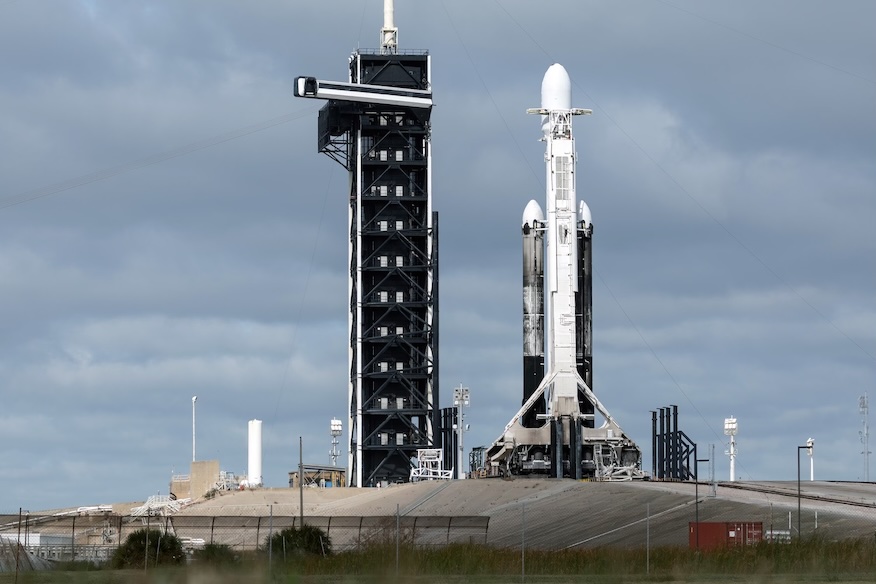
For the second time this month, SpaceX is gearing up to launch the X-37B military spaceplane onboard its Falcon Heavy rocket. Liftoff of the USSF-52 mission from NASA’s Kennedy Space Center is set for 8:07 p.m. EST (0107 UTC) on Thursday at the opening of a ten-minute launch window.
The launch attempt comes after SpaceX and the U.S. Space Force had to delayed the mission from Dec. 11 due to “a ground side issue”. The Falcon Heavy was returned to its hangar on Dec. 14 with SpaceX no longer sayingthe vehicle remained ‘healthy’ in its social media posts.
SpaceX didn’t elaborate on the reason or reasons for the delay, but multiple sources tells Spaceflight Now that at least one engine had to be replaced on the Falcon Heavy rocket. A second static fire test was deemed unnecessary, which allowed SpaceX to get in another launch attempt before the end of the year and reschedule the mission for Dec. 28.
Onboard the three-core rocket is the X-37B Orbital Test Vehicle (OTV). This will be the seventh launch in the program’s history since 2010 and the fourth flight of Vehicle 2 the second of two craft in the OTV fleet.
Spaceflight Now will have live coverage of the launch from the Kennedy Space Center starting about 1.5 hours ahead of liftoff.
[embedded content]
The Falcon Heavy rocket for this mission rolled back out to the pad at Launch Complex 39A Wednesday morning. It will mark the second time SpaceX will launch the X-37B after previously giving it a ride on a Falcon 9 on the fifth OTV mission in September 2017.
All other previous mission were launched using United Launch Alliance’s Atlas 5 501 rocket from neighboring pad 41.
More information about the X-37B and the importance of the mission for both SpaceX and the U.S. Space Force can be found here.
About 8.5 minutes after liftoff, the two Falcon Heavy side boosters, tail numbers B1064 and B1065, will return to Landing Zone 1 and 2 at Cape Canaveral Space Force Station. Those watching the launch in person may hear a pair of sonic booms as they reenter the atmosphere.
These boosters are making their fifth flight to date after launching the USSF-44, USSF-67, Jupiter-3 and Psyche missions previously. They will be launched one more time in October 2024 to launch NASA’s Europa Clipper spacecraft to the Jovian moon of the same name.
Planting the seeds of progress
While the payloads on board the spaceplane are mostly undisclosed, the mission will be another opportunity for NASA to learn about the impacts of long-duration spaceflight for humans.
No astronauts will be onboard the flight, but NASA is sending up a sequel to its RAD-SEED 1 and RAD-SEED 2 experiments.
“For this mission, we will send new types of seeds mainly for leafy greens,” said a NASA spokesperson in a statement. “We are also sending different varieties of the same type of seeds, aiming to evaluate the differences between/among these varieties in response to the space environment.”

The new varieties of seeds include cauliflower, amara, scarlet frill and garnet giant. They are also sending up two varieties of each of the following: radish, pac choi, peppers and brachypodium.
Along with eight varieties of Arabidopsis, here are the other seeds that will be onboard the X-37B:
- Lettuce
- Mizuna
- Tomato
- Swiss chard
- Onions
- Wheat
- Cucumber
- Rice
- SEO Powered Content & PR Distribution. Get Amplified Today.
- PlatoData.Network Vertical Generative Ai. Empower Yourself. Access Here.
- PlatoAiStream. Web3 Intelligence. Knowledge Amplified. Access Here.
- PlatoESG. Carbon, CleanTech, Energy, Environment, Solar, Waste Management. Access Here.
- PlatoHealth. Biotech and Clinical Trials Intelligence. Access Here.
- Source: https://spaceflightnow.com/2023/12/28/live-coverage-spacex-takes-second-swing-at-launching-falcon-heavy-rocket-x-37b-military-spaceplane/



